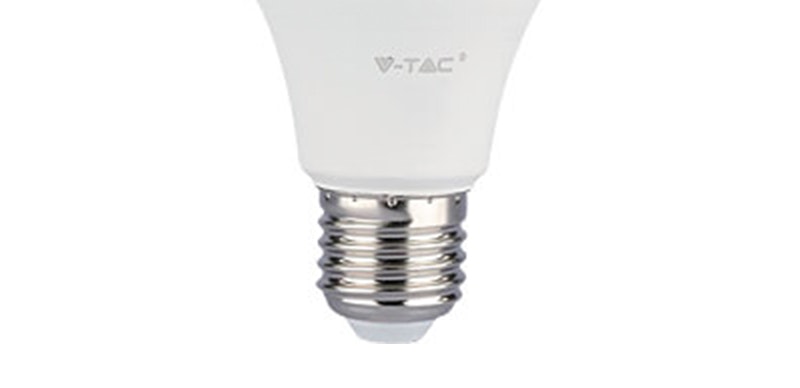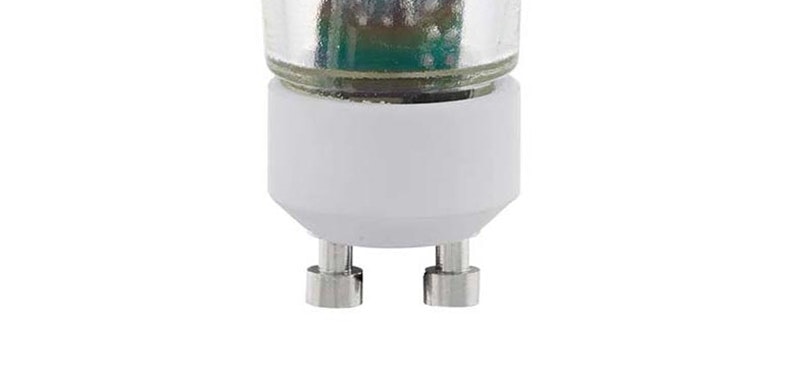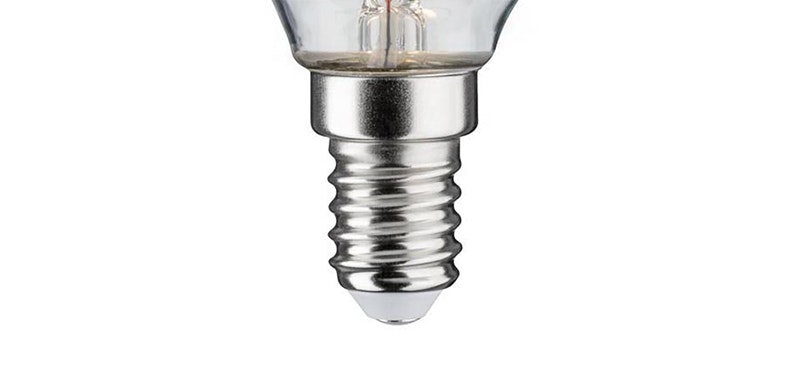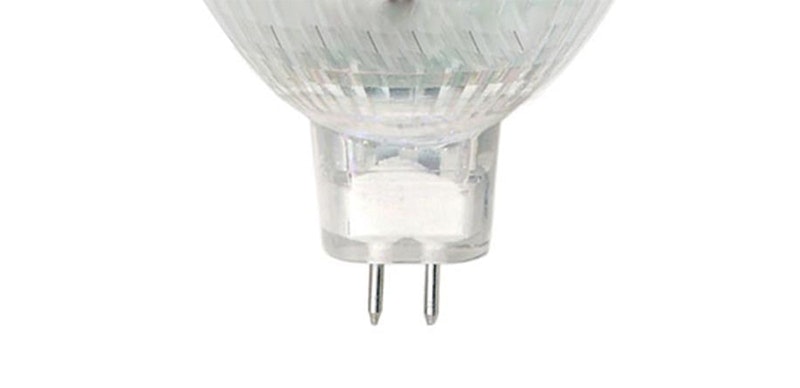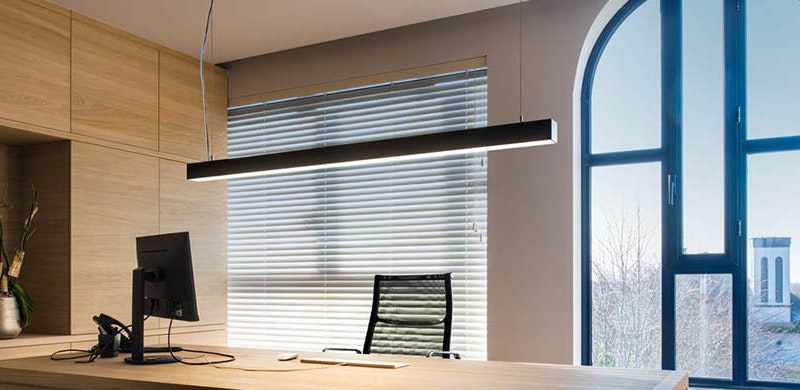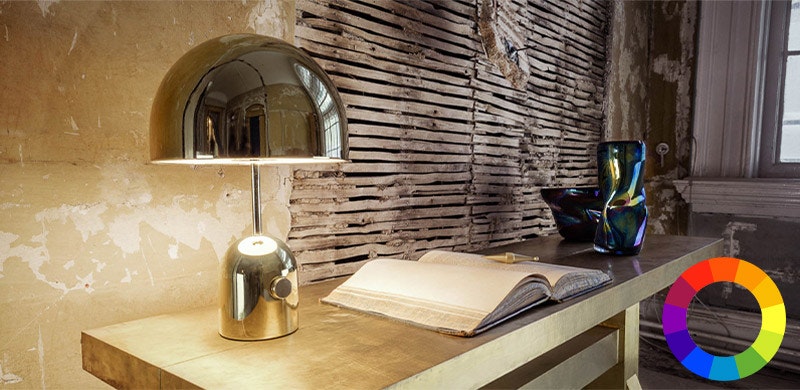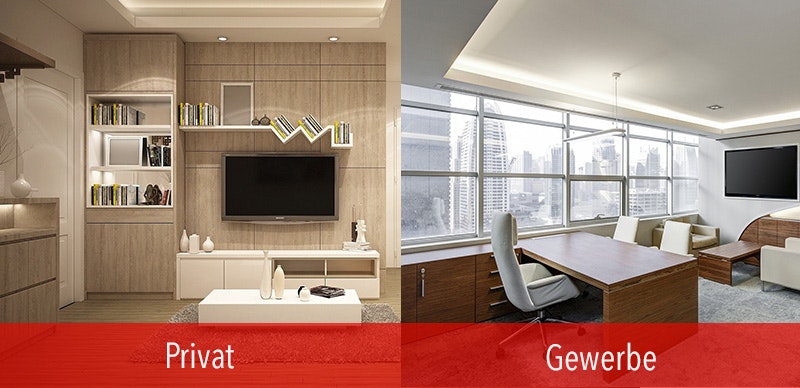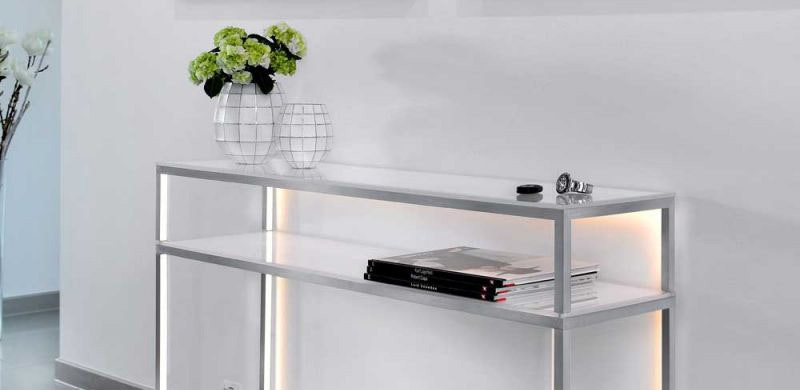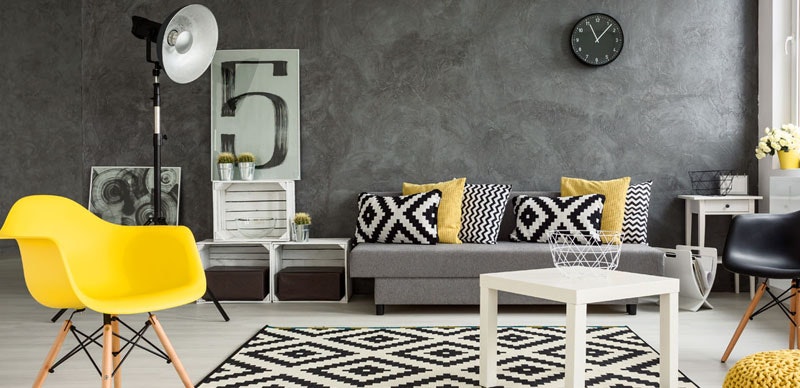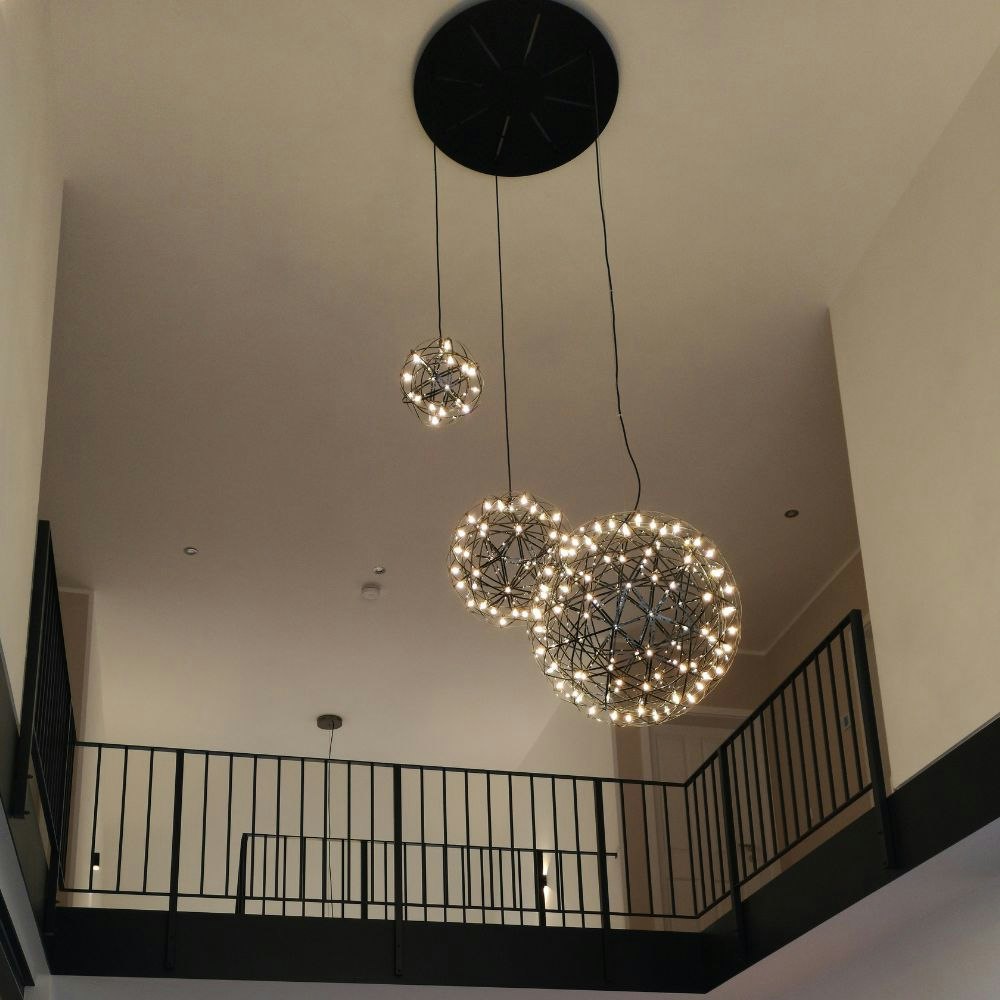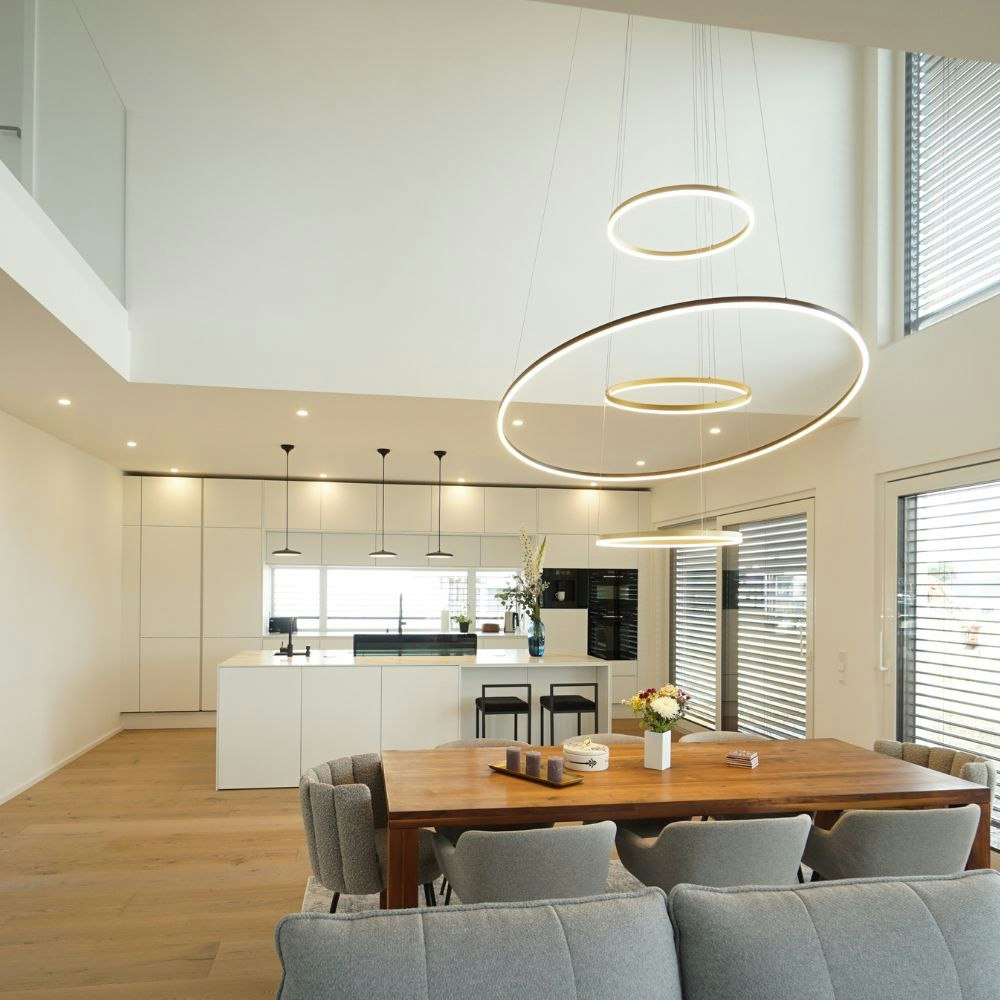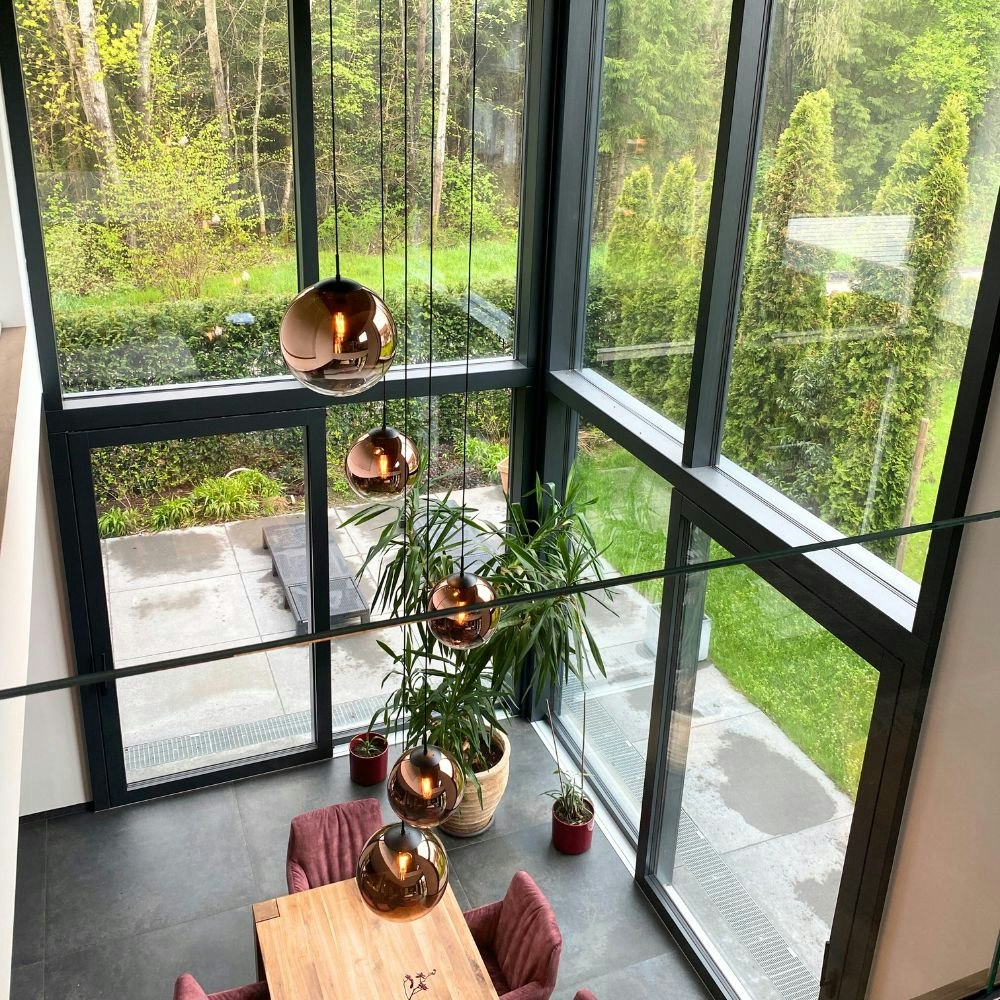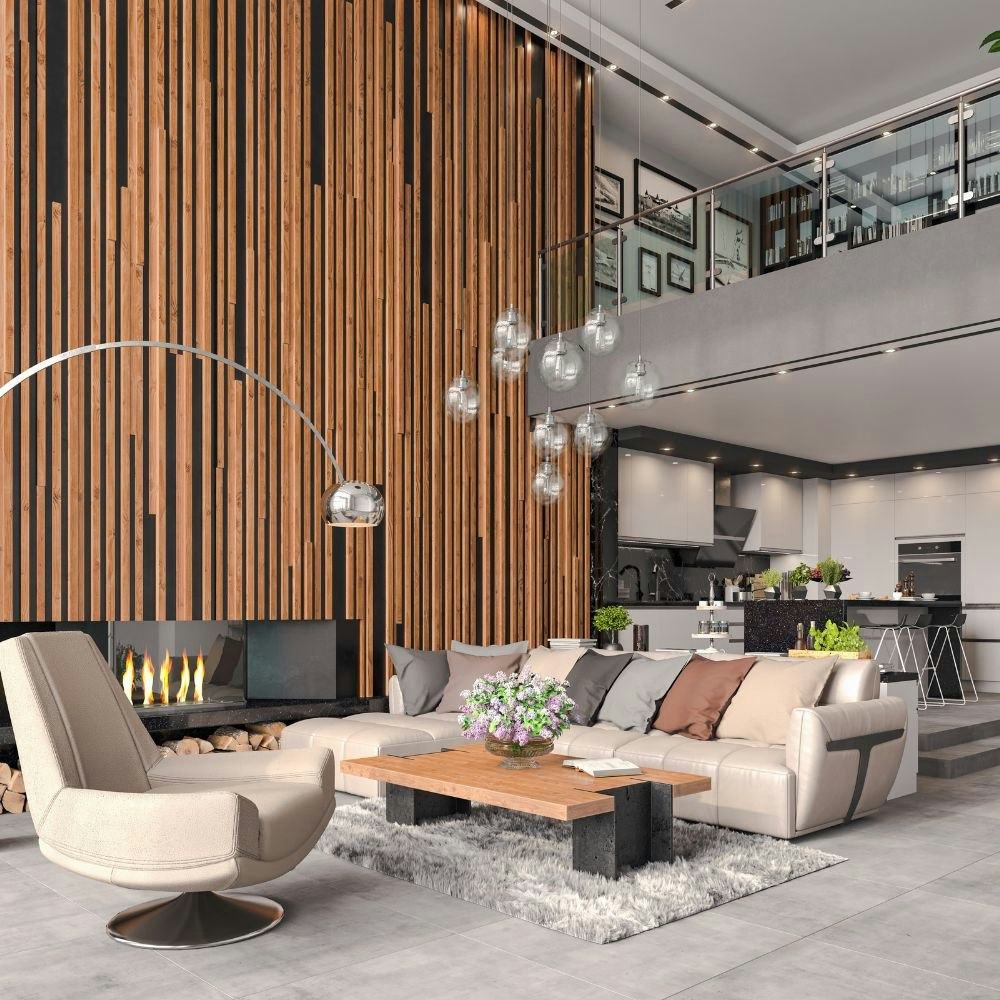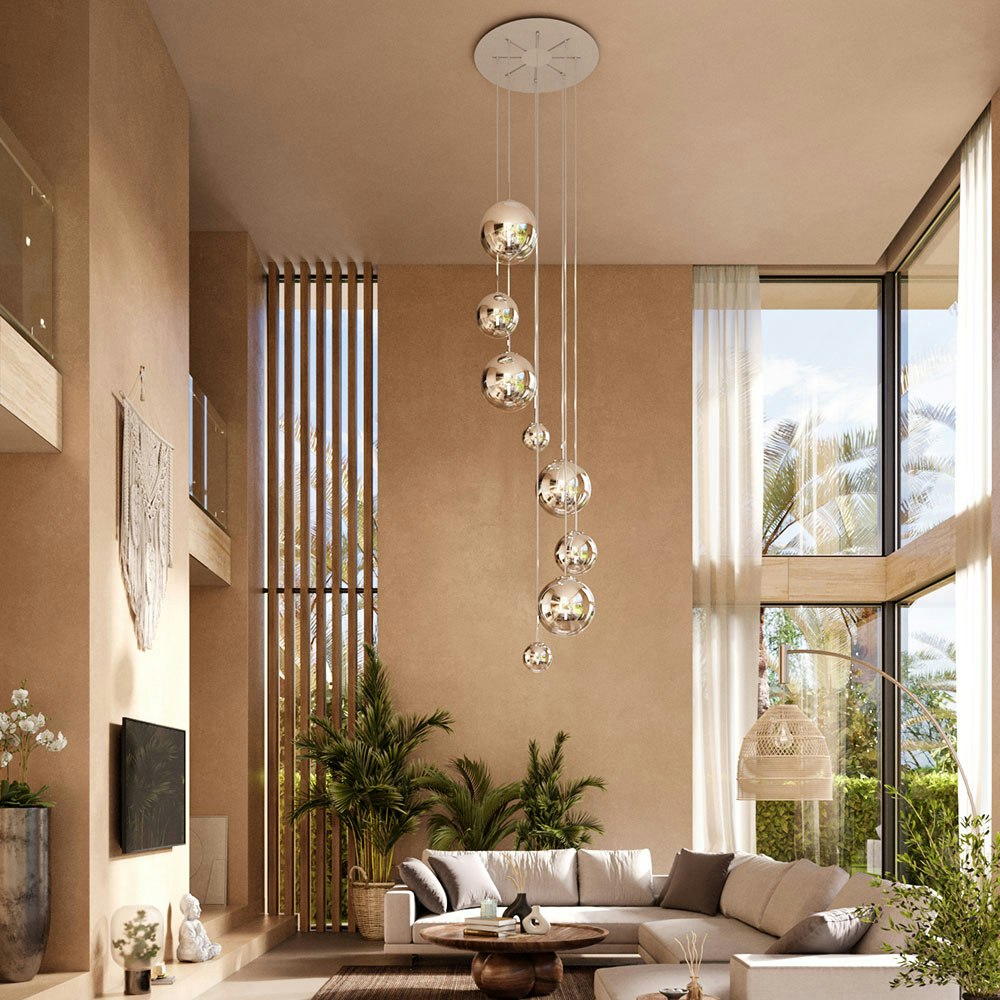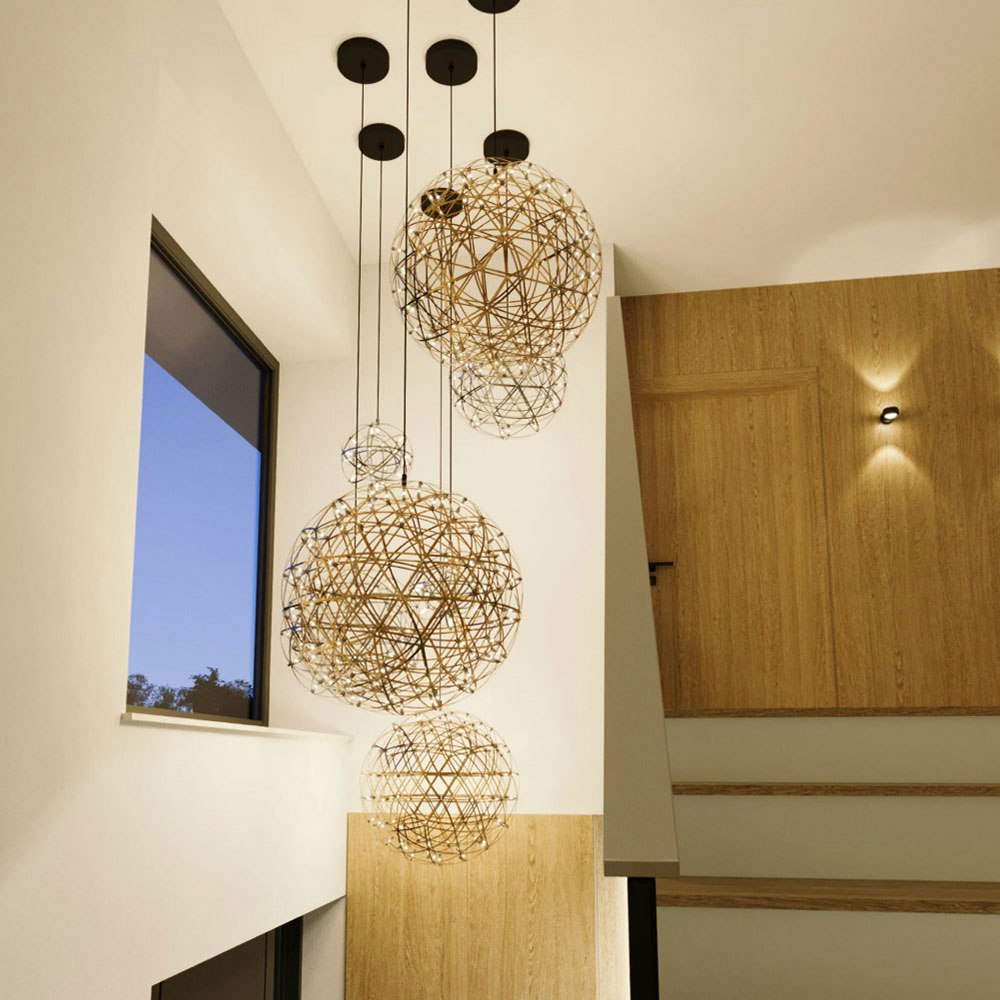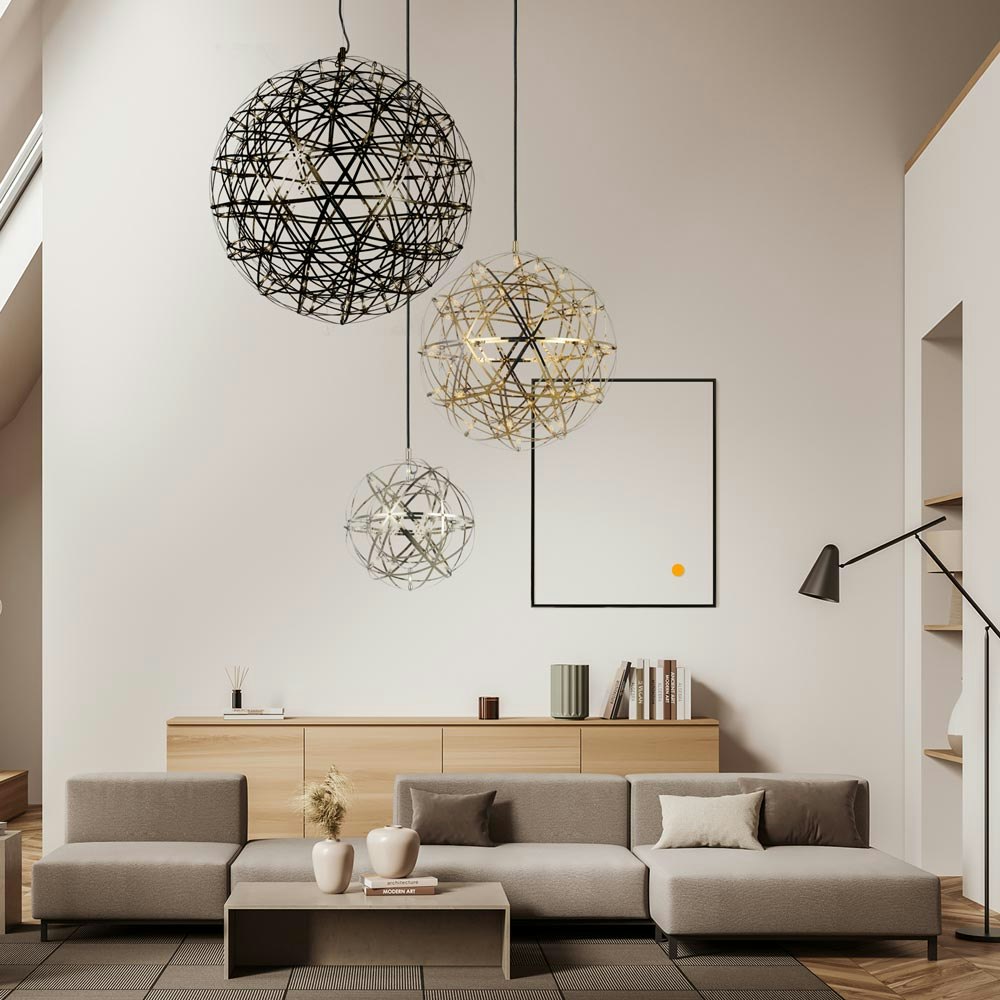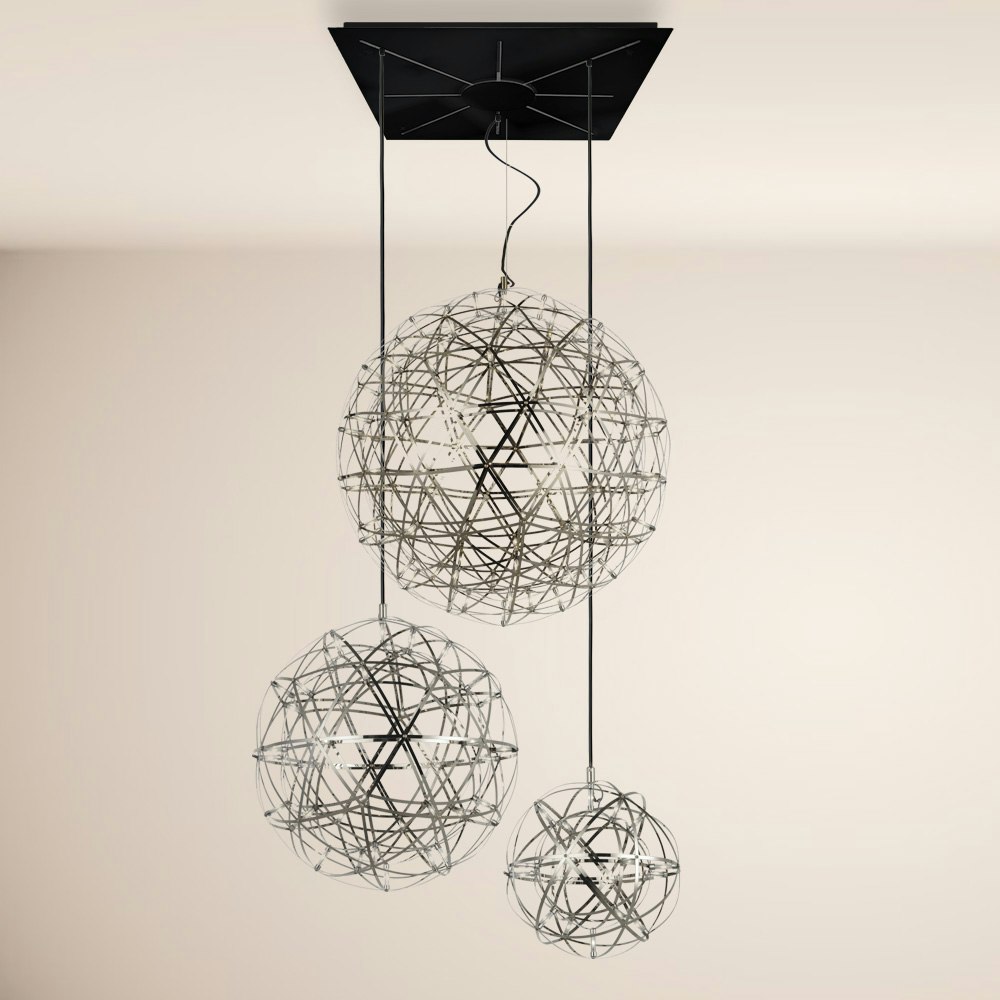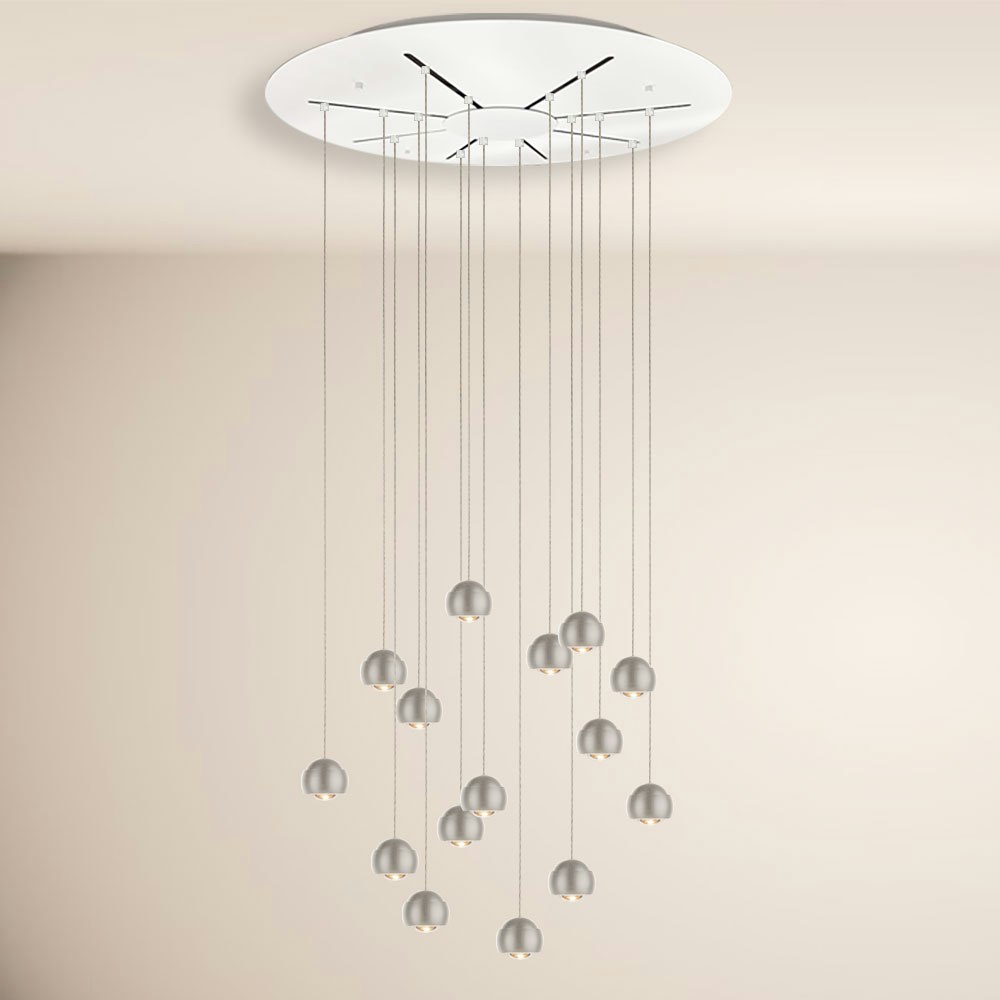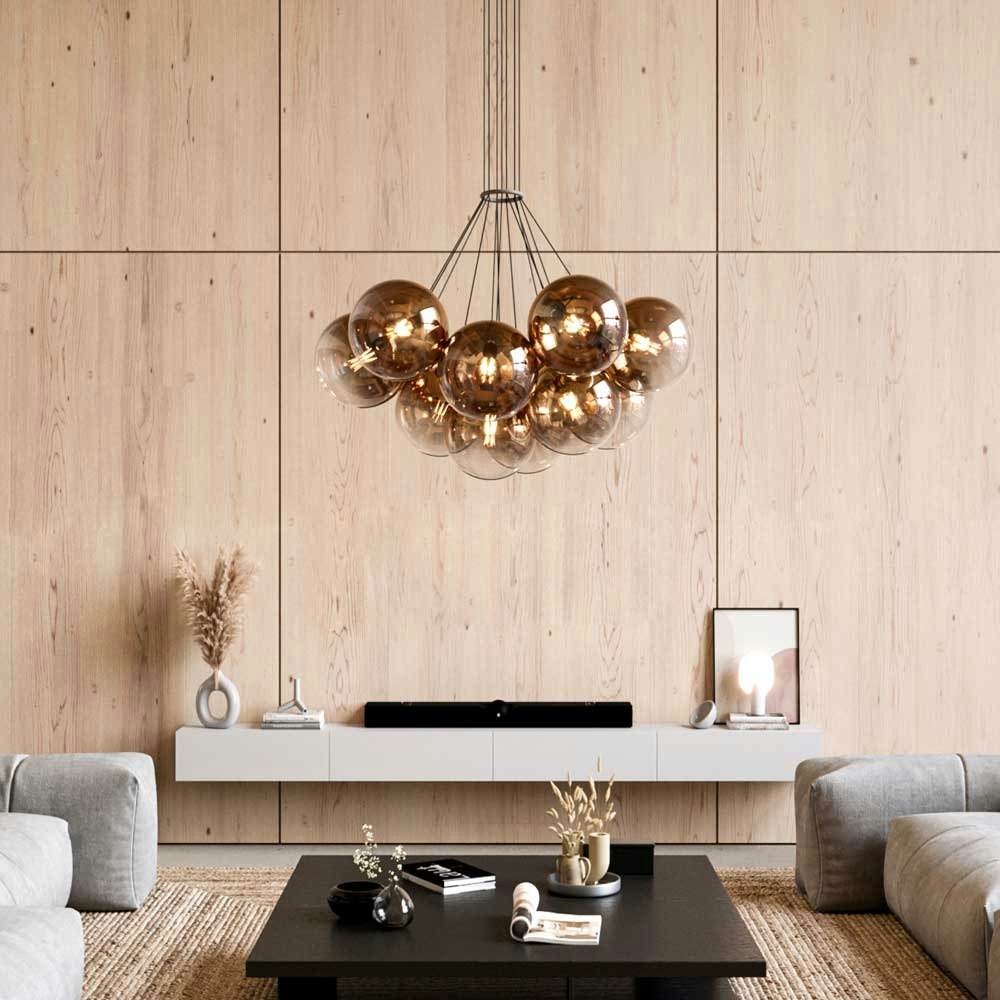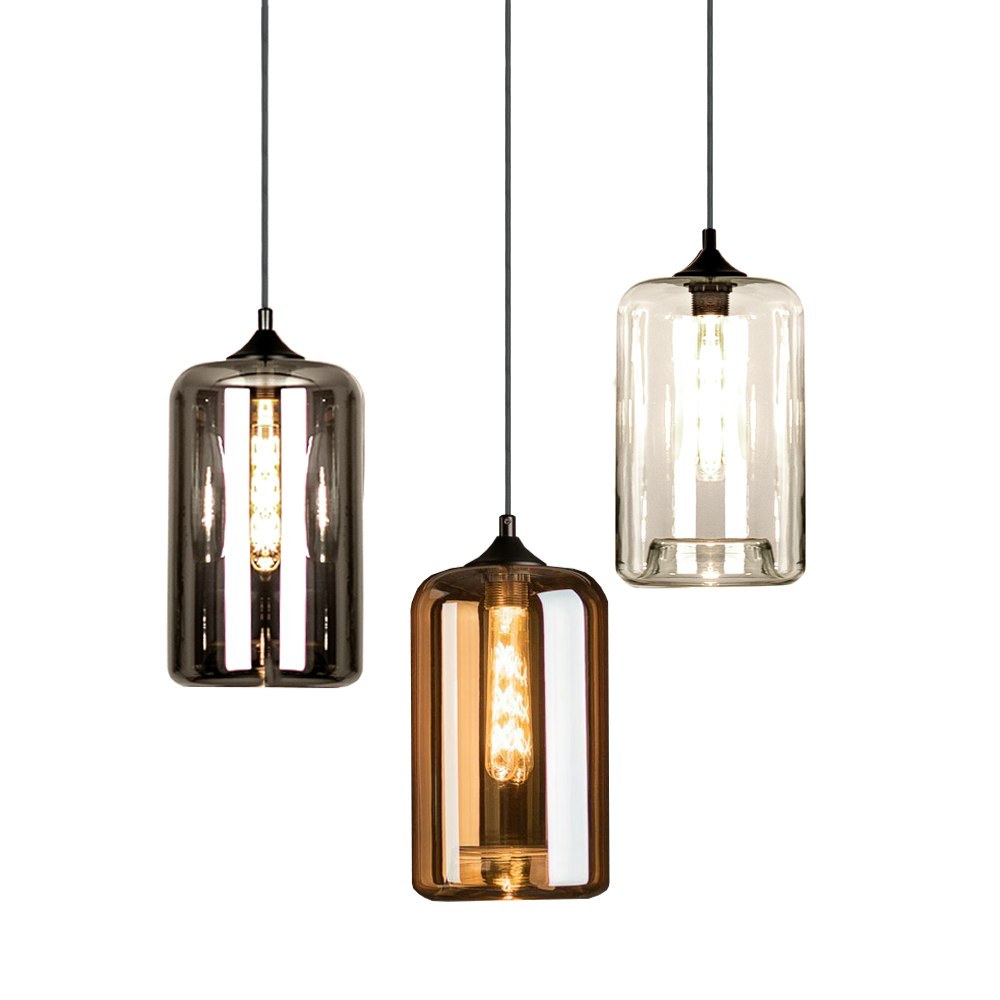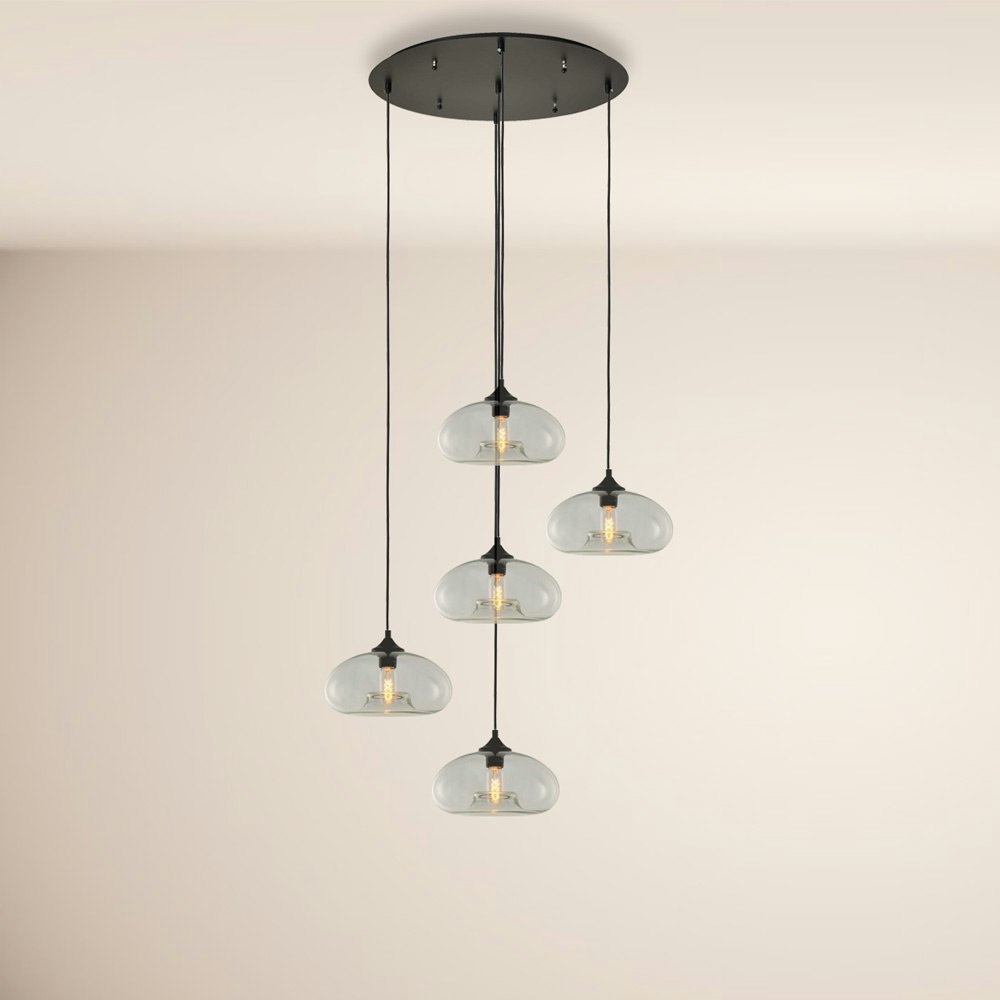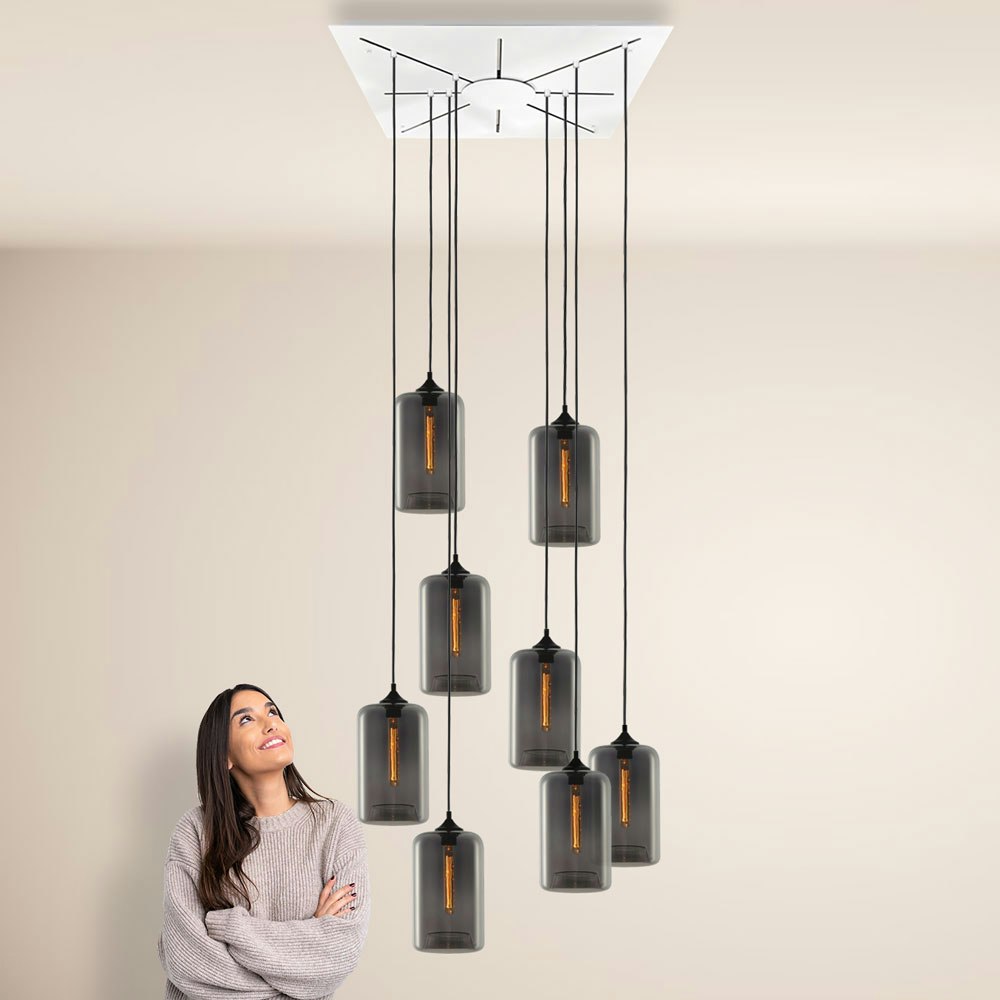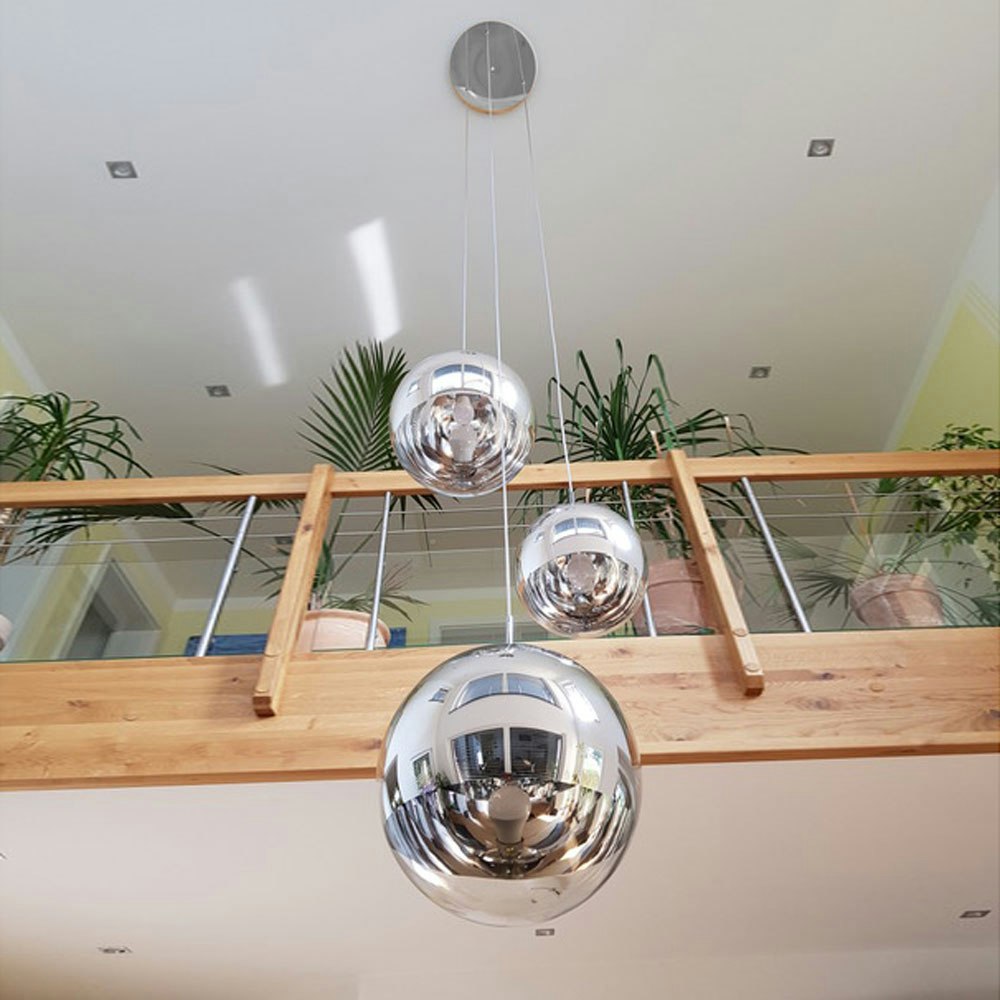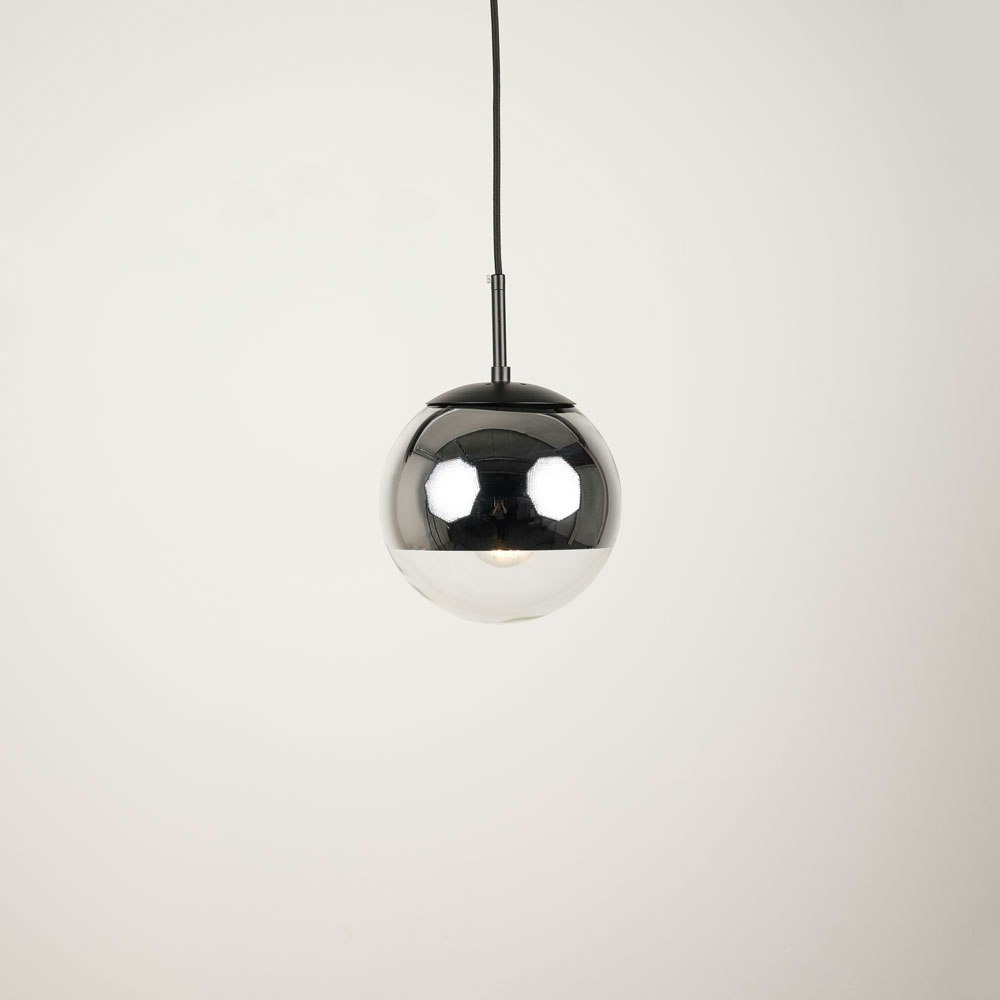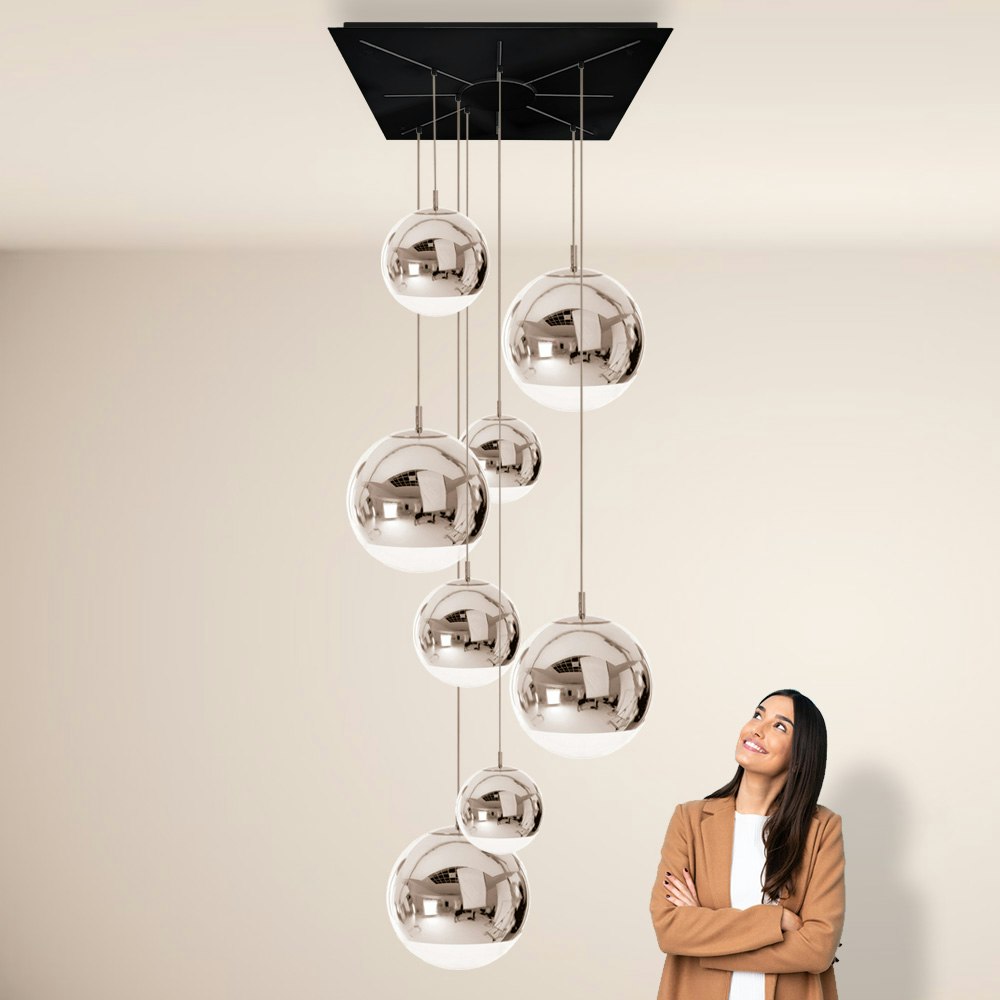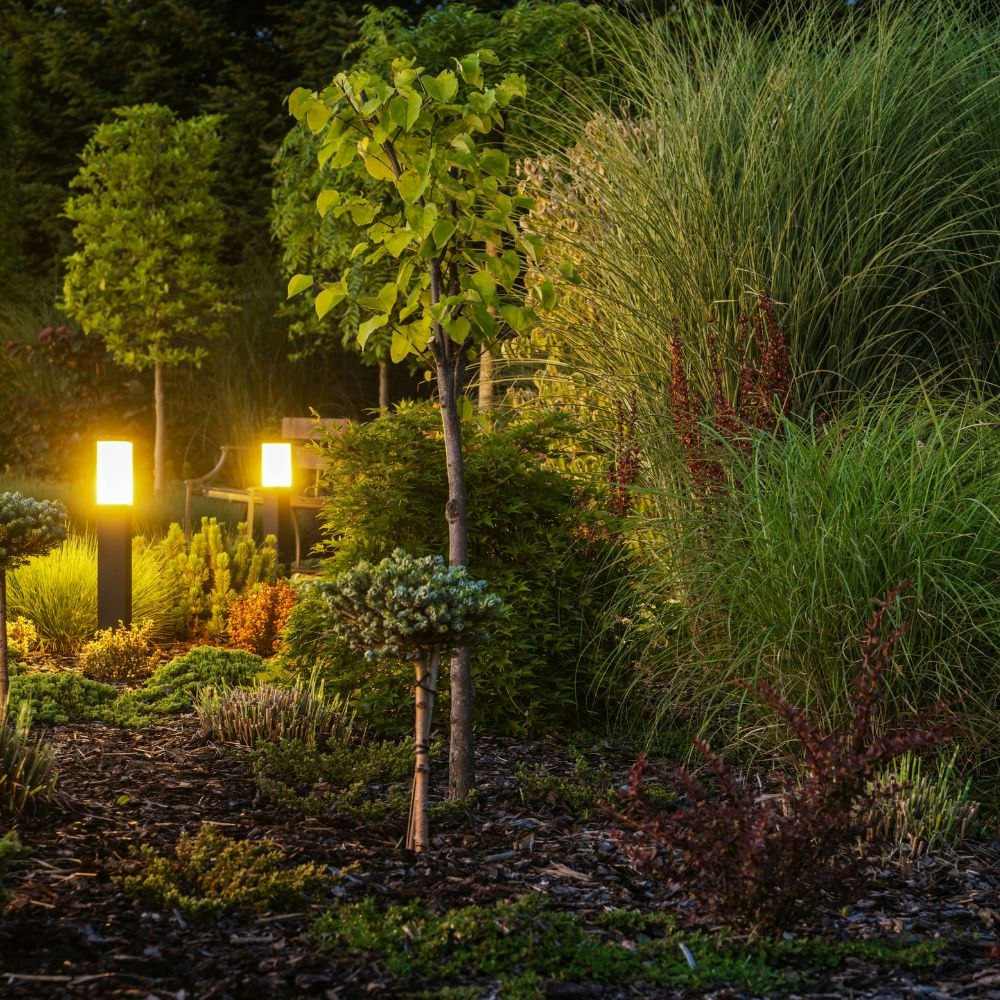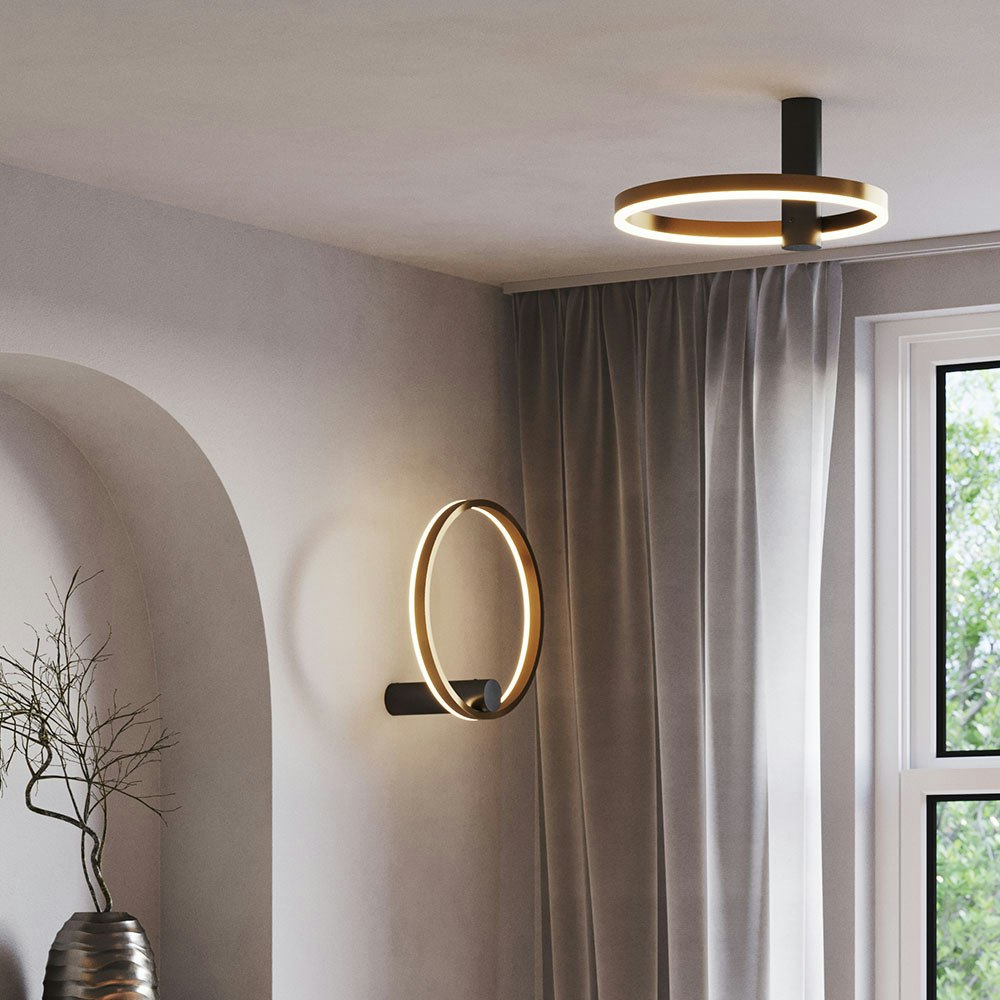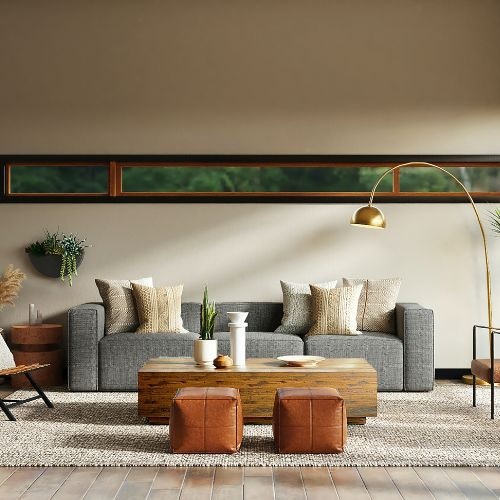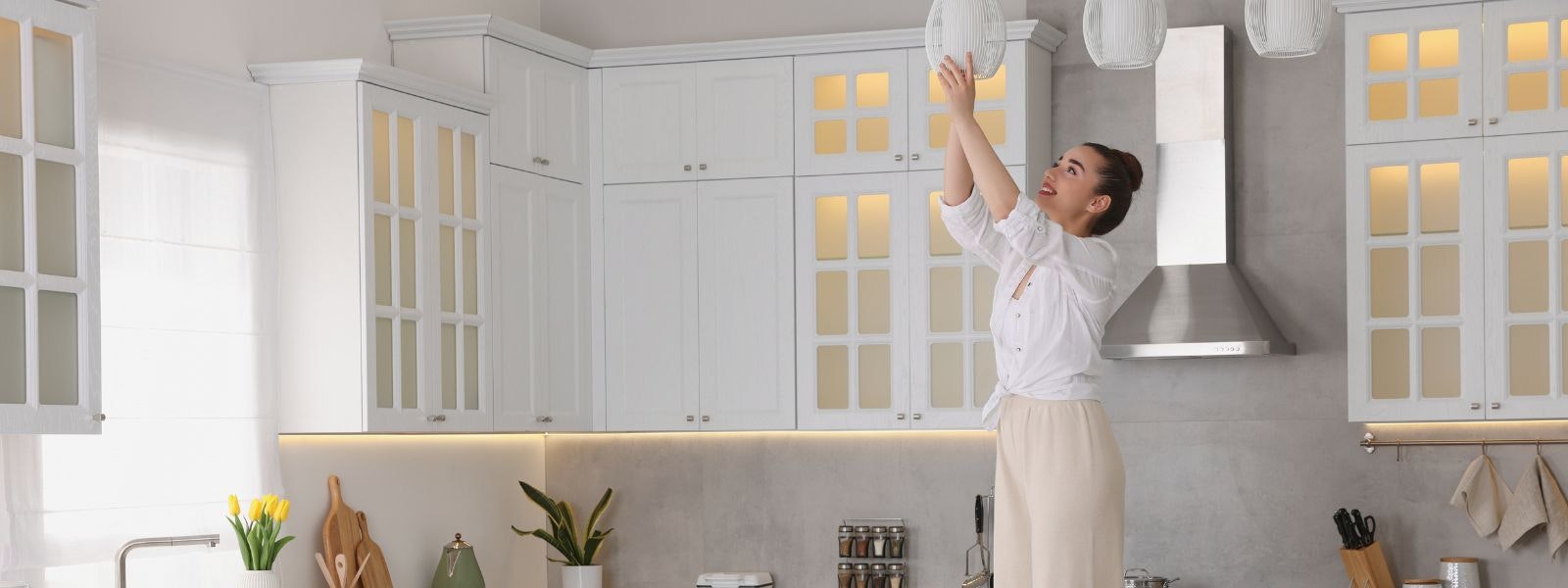
Lighting for high rooms
How to design optimal lighting for high ceilings
Pendant lights and chandeliers:
If you have a high ceiling, you can use this to your advantage by using pendant lights or chandeliers. This type of lighting can create an impressive visual impact while bringing light to the entire room. Choose a fixture that matches the style of the room. A modern chandelier can look good in a contemporary room, while an antique pendant light is more appropriate in a more traditional setting.
Use indirect lighting:
Indirect lighting is a great way to create a soft and even light in a room with high ceilings. You could install wall sconces or mouldings that radiate light against the ceiling or walls. The reflected light is less harsh than direct lighting and can help create a warm and inviting space.
Use floor lamps and table lamps:
To illuminate dark corners in a room with high ceilings, you can use floor and table lamps. These lights can help make the room cosier while illuminating areas that might otherwise be in shadow.
Interior design lights:
For high ceilings, it can be useful to use special interior design luminaires. These luminaires are designed to be mounted in specific areas of the ceiling to provide targeted lighting. They can also be used to highlight certain features of the room, such as artwork or architectural details.
Smart Lighting:
With the development of technology, it's now possible to control your home's lighting from your smartphone or with voice commands. You could install dimmable lights and set them to adjust automatically throughout the day. This can be especially helpful in rooms with high ceilings, where changing light bulbs can be more cumbersome. Lighting rooms with high ceilings doesn't have to be complicated. With proper planning and the right fixtures, you can create a stunning, well-lit space that is both functional and stylish. Always remember that lighting is an important part of interior design and can do a lot to set the tone and atmosphere of your room. Good lighting can turn a beautiful room into an extraordinary space.

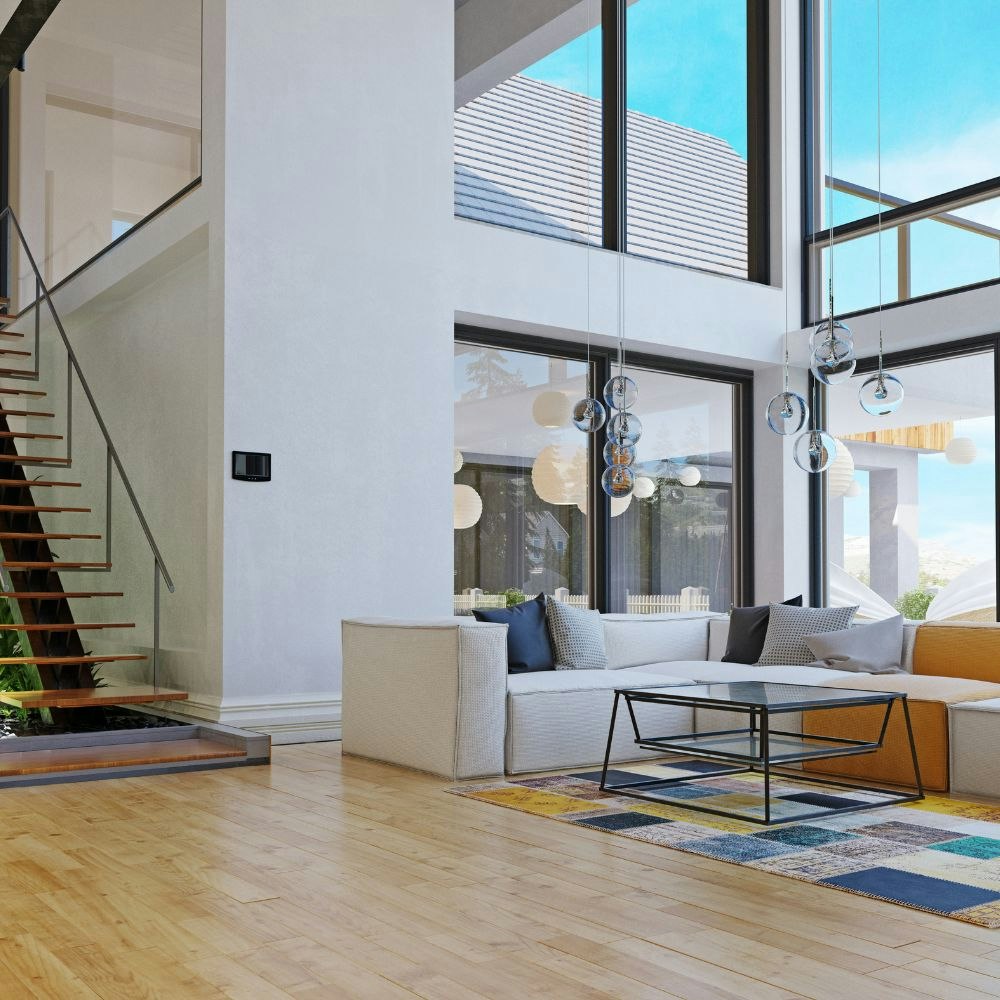
Use of spots and spotlights:
In rooms with high ceilings, spots and spotlights offer another option for lighting. They can be mounted on the ceiling or along beams to highlight specific areas or elements in the room. They are great for highlighting artwork on the walls or illuminating a work surface in the kitchen.
Use natural light:
If your room has large windows or skylights, make the most of these natural light sources. Natural light can brighten up a room and give it an open and airy feel. With the right window treatments, you can control how much light enters the room, varying the lighting throughout the day.
Use layers of light:
Effective lighting for high ceilings is often based on the principle of layering light. This means that you combine different light sources to achieve balanced lighting. For example, you could use a combination of pendants, wall lights, floor lamps and spotlights to illuminate both the entire surface of the room and specific areas.
Choose the right colour temperature:
The colour temperature of your lights can have a big impact on how the room is perceived. Warm white light (2700K - 3000K) creates a cosy, inviting atmosphere, while neutral white or daylight white light (3500K - 6500K) tends to create an active, energetic environment. Warm white light is often preferred for living areas, while neutral white or daylight white light tends to be used in work areas.
Seek professional advice:
When lighting rooms with high ceilings, it can be helpful to seek professional help. A lighting designer or interior decorator can help you create a lighting plan that makes the most of the space and takes into account all your needs.
Designing lighting for rooms with high ceilings can be challenging, but with a little planning and thought, you can create a beautifully lit space that is both functional and visually appealing. With the right lights and placement, your high-ceilinged room can become the glowing focal point of your home.
Which luminaires form the base layer of the lighting?
The materials and colours used in your room will also affect how light is reflected and how the room is lit overall. Light colours and shiny surfaces reflect light more and can help make a room with high ceilings brighter. Dark colours and matt surfaces, on the other hand, absorb more light, which can make the room appear darker. A combination of both can be used to create a balanced lighting picture. The placement of light sources also plays an essential role in designing lighting in high rooms. It is important to consider both the height of the light sources and their distance from each other. Lighting fixtures placed too close to the ceiling can cast harsh shadows, while fixtures placed too far apart can leave dark areas in the room.
It is also worth considering the use of the room. If the room is mainly used for relaxing and cosy get-togethers, warmer, softer light sources should be preferred. In a room where work or study is done, brighter light and luminaires that illuminate specific work areas are advantageous. Energy efficiency is another aspect to consider when designing lighting for high ceilings.
LEDs are a good choice because they use less energy and last longer than traditional incandescent bulbs. They are available in a variety of colour temperatures and intensities, so you can choose the light that best suits your needs and preferences. Last, but no less important, it is crucial to consider lighting as part of the overall room design. Lighting should complement and highlight the architecture, furniture and décor, not work against it.
Through careful planning and thoughtful lighting choices, you can ensure that your high-ceilinged space is well-lit, functional and aesthetically pleasing. By considering all of these factors - from the type of lighting, to the placement of fixtures, to the choice of bulbs, to the colour temperature, to the reflective properties of the space, to the inclusion of energy efficiency and use of space - you can develop a lighting plan that will ensure that your high-ceilinged space shines in the best light. A well-lit space not only improves the sense of space and aesthetics, but also increases the functionality and well-being of its users. With patience and care, you can create a high ceiling space that is as inviting as it is impressive.
How to install luminaires in high spaces?
In addition to the previous considerations, maintenance and flexibility of lighting solutions should also be taken into account. With high ceilings, luminaires can be harder to reach and therefore more difficult to clean or replace. Therefore, it may make sense to use long-lasting light sources such as LEDs that rarely need to be replaced. For flexibility and adaptability to different moods and activities, lighting systems with dimmable lights or with smart home integration are helpful.
With these systems, you can easily adjust the brightness and colour temperature of the lighting to create the ideal atmosphere for any situation. Sometimes rooms with high ceilings can also have acoustic challenges, as they often generate more echo. In such cases, acoustic panels hanging from the ceiling could provide both an acoustic and lighting solution, as they often come with built-in LED lights.
Despite the challenges of lighting rooms with high ceilings, they also offer the opportunity to play with light in creative and impressive ways. You could install a range of pendant lights at different heights to create an interesting and dynamic lighting pattern, or you could highlight architectural details such as beams, arches or niches with targeted lighting.
Remember that the key to successfully lighting rooms with high ceilings is to consider the specific needs and characteristics of the space and develop a balanced lighting scheme that combines ambient, task and accent lighting. With careful planning and a clear understanding of lighting design, you can create a high ceiling space that is bright, inviting and stylish.
What mistakes should you avoid when lighting high spaces?
Over-lighting:
Often people tend to add more light, thinking it will make the room brighter. But too much light can lead to the room being over-lit, which can cause glare and make it feel uncomfortable overall. Instead of flooding the room with too much light, try to create a balanced mix of ambient, task and accent lighting.
Incorrect placement of lights: Incorrect placement of lighting can cause the room to be unevenly lit or create shadows in the wrong places. For example, pendant lights should not be hung so high that they cast light directly into the eyes, nor so low that they obstruct passage.
Inappropriate light sources:
When choosing light sources, it is important to choose the right colour temperature, brightness and colour rendering index. A common mistake is to use bulbs with too cold a colour temperature, which can produce a harsh, uncomfortable light, or bulbs with too low a CRI, which distort the colours in the room.
Not considering maintenance and accessibility:
Luminaires in high ceilings can be difficult to reach when bulbs need to be changed or luminaires need to be cleaned. Therefore, it is important to choose luminaires that have a long service life and are easy to maintain.
Insufficient flexibility:
In many rooms with high ceilings, a variety of activities will take place and the lighting should be able to adapt to these activities. The lack of dimmable luminaires or a system to control the lighting can mean that the lighting is not flexible enough to support different moods and activities.
Failure to consider room proportions:
Even if high ceilings create a spacious room, the proportions of the room should be taken into account when lighting. A luminaire that is too large or too small can upset the balance of the room and detract from the overall effect. By avoiding these mistakes, you can ensure that the lighting in your high ceiling room is effective, comfortable and aesthetically pleasing. With careful planning and consideration, you can create a well-lit space that is both functional and visually appealing.

Gallery luminaires in high spaces
Gallery luminaires are a wonderful lighting option, especially for high spaces and particularly those that showcase artwork or specific design elements. They provide both effective lighting and a way to highlight certain features in a room. Gallery lights, sometimes referred to as artificial lights or picture lights, are specifically designed to illuminate artwork or other elements. They provide a directional light that serves to draw attention to the illuminated object and highlight its colours and details. In rooms with high ceilings, gallery lights can have a particularly impressive effect. They can help to emphasise the verticality of the room and give the eye a line to follow upwards. They can also help to brighten dark corners and give the room a more balanced lighting overall.
There are several things to consider when installing gallery lights in a room with a high ceiling. One of the most important is the placement of the lights. They should be positioned so that they illuminate the artwork or object they are lighting well, without causing glare or casting distracting shadows. This usually requires careful planning and possibly some trial and error to find the right position. Choosing the right light sources is also crucial. Light sources for gallery luminaires should have a high colour rendering to represent the colours of the illuminated object as accurately as possible. LEDs are a good choice because they offer high colour rendering and are available in a variety of colour temperatures.
In addition to illuminating artwork, gallery lights can also be used to illuminate other elements in a room with a high ceiling. For example, they can be used to highlight a wall with textured wallpaper or stone, or to highlight an architectural feature such as an alcove or arch. Overall, gallery luminaires are an excellent choice for lighting rooms with high ceilings. They offer a way to both illuminate the room as a whole and highlight specific features, making them both practical and aesthetically pleasing.
Conclusion - This is how you do everything right!
The buzzing of a lamp can have various causes - from the wrong type of bulb to faulty dimmer switches to wiring problems. It takes both technical understanding and careful investigation to identify the source of the problem.
Always remember: your safety comes first. If you are unsure or if the buzzing continues, you should not hesitate to consult a professional. With the right solution, your lamp can shine safely, efficiently and quietly.
If you are still undecided about how to implement lighting in your home, why not make an appointment with the lighting planners at Skapetze for personal advice and the development of an individual lighting concept ?
You are also welcome to visit us on site in Simbach am Inn at , Bavaria's largest lighting studio .
If you already have a concrete idea of how the luminaires should look in your home, we can help you turn this idea into reality - our in-house workshop makes it possible.












